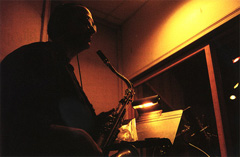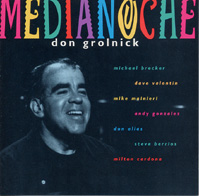

|
Soundclip:
|
| See Steve's Hand-Written Solo
Transcription |
Michael
Brecker's Tenor Sax solo on:
"Cape Verdean Blues"(Horace
Silver)
This transcription becomes the 4th, but not the last, in our series of Michael Brecker tenor sax solos from Don Grolnick's "MEDIANOCHE," recording. Here we feature Mike playing a 1-chorus solo over "Cape Verdean Blues" written by the great pianist/composer Horace Silver. For those of you who are coming to these pages for the first time, you might want to read what I've written as background information for the prior solos shared here, which included: "Rainsville"; "Rojo y Negro" and "If Ever I Should Leave You" from that same recording. Those of you who have been visiting the site specifically for these solos, you can probably just skip the following paragraph. In 1995, my dear friend, pianist/composer/arranger Don Grolnick recorded his final CD "MEDIANOCHE" which was eventually picked-up and released by Warner Bros. Sadly, it was not too long after that, we all lost Don to a battle with lymphoma. To this day, Don is missed tremendously by his family, friends, and by all those who loved his playing and compositions. Don and I were close friends and musical associates for nearly 30 yrs. and, in some small way, I feel like I had a hand in this recording. You see, it was many years before when I gave Don my 'extra' LP copy of Cal Tjader's recording, "SOUL BURST," which features some brilliant playing by Chick Corea. Don always loved this recording and when he decided to explore the world of Latin jazz, this recording, its feel, its attitude and even many of its tunes became the model for the band he assembled. A band which included longtime colleagues like Michael Brecker, Mike Mainieri, Don Alias and, from the Latin world, Dave Valentín, Andy González, Milton Cardona, and Steve Berrios. Michael's solo here is a work of great fire and intensity while still embracing elements of blues and soul!!!It should also be noted that, like most of the solo transcriptions shared here, this is written in concert key, but it is written in the register of the guitar which means that it is written one octave above where it actually would sound on a piano. So, always keep that in mind!!!  As always, we want to take a look at the composition and just how Horace Silver laid it out for soloing. What is so fascinating about this tune, is its form. At its core, it is an A-A-B-A type of tune. However, and I'm certain that it was something instinctive, Horace felt that this particular [B] section should be repeated. And so, the form, as you will hear and see, becomes [A] [A2] [B] [B2] [A3]. Each section is always 16 bars in length. As always, we want to take a look at the composition and just how Horace Silver laid it out for soloing. What is so fascinating about this tune, is its form. At its core, it is an A-A-B-A type of tune. However, and I'm certain that it was something instinctive, Horace felt that this particular [B] section should be repeated. And so, the form, as you will hear and see, becomes [A] [A2] [B] [B2] [A3]. Each section is always 16 bars in length.Harmonically speaking, in my view, it sounds as though this piece was very influenced by Latin music anyway because all the [A] sections simply go back and forth between Cm7(i minor) and G7(alt.)(V7). However this is accomplished as a type of harmonic 'sandwich,' where you have 4 bars of Cm7, then 8 bars of G7, and finally another 4 bars of Cm7. This type of harmonic movement is very, very common in Salsa and other Latin forms as well. It is no less common for a 'bridge,' 'moña' or 'coro' section to then go down a whole-step to a dominant 7th type chord. This is exactly what happens here as the [B] sections go to a Bb7(13) chord and then back up to Cm7, with a little turnaround, passing from D7(alt.)[the V of V] to G7(alt.), which brings us back to our [A] section. For his arrangement, no doubt with the rhythmic advice of Andy, Milton and Steve, Don plays the tune with a Calypso-oriented feel in a 3:2 clave. My dear friend from Caracas, Rafael Greco opines that the feel for the [A] sections is a rhythmic fusion of elements, which could include: "plena"(based upon Milton's conga tumbao), and Steve Berrios' hi-hat pattern, which sounds very "merengoso"(like the güiro in a merengue). The [B] sections seem to feature, as Rafa explains, "algún golpe de batá." For the moment, that is the best I can do, where an explanation is concerned, as I remain very much a novice in this rich, rich genre of music! For each solo, the first two [A] sections are played without any harmonic accompaniment. As someone who has worked and recorded with Mike Brecker on countless occasions, I know that he, like many great tenor sax players, loves playing alone with just bass and rhythm. Obviously, this affords him greater linear freedom and alleviates the potential for any accidental harmonic clashes. It becomes especially obvious over the V7(alt.) chord in a minor key. So here, you might want to pay special attention to what Mike plays over the G7(alt.) areas during the letter [A] sections. Over the Cm7 areas during the [A] sections, Mike sticks to a language which is drawn from the C minor pentatonic scale(C, Eb, F, G, Bb), the C blues scale. But, you'll notice that he doesn't really utilize the full C Dorian mode(C, D, Eb, F, G, A, Bb) much at all as he stays away from the notes 'D' and 'A.' Other than appearing once as a 'passing tone' and a 'neighboring tone,' 'A' only appears briefly in bar 3 of [A] and not again until bar 13 in [A3]. Because this tune is so rooted in the minor chord sound, when a V7 chord appears, unlike when you are in major or dominant areas for longer periods of time, you would want to avoid the natural 9(in this case 'A') and the natural 6/13(in this case 'D') over the V7(alt.) chord, here our G7. So, during those bars, you should expect to see more Ab's and Db's. Though a 'D' is much more likely to appear on occasion than an A-natural!!! Speaking as a guitarist, it always fascinates me how you can look at the written note on the page, then play those notes, even play those notes with personal interpretation and feeling, and it STILL will NEVER sound like the saxophone!!! For example, if you look at what Mike plays in bar 5 of [A], where he simply outlines the guts of a G7#9 chord, it appears to be so simple, but the inflection that he puts on the Bb, when it is played, gives it such character and even makes it sound like a more "far out" note than it actually is. The longer line which follows is full of jazz linear mannerisms in this harmony, with an emphasis again on Ab, the b9. But there's a beautiful moment when he arrives at bar 9, and he hits that higher Db, with feeling.  What he plays in bar 10 is a perfect example of what I was speaking of earlier with regards to soloing with no chordal accompaniment. In this bar, Mike plays a brief sequence and what see/hear in the 1st half of the bar, Bb-Ab-E-B, might not have sounded so good had there been chords behind him. Normally, over a V7 chord which has to resolve to minor at some point, you would never want to play the natural 6 or 13 because it is, in essence, about to become the major 3rd of the minor chord. So, other than as an upper neighbor, or some kind of a passing tone, you would not expect to hear E-naturals over a Cm7 chord!!!
What he plays in bar 10 is a perfect example of what I was speaking of earlier with regards to soloing with no chordal accompaniment. In this bar, Mike plays a brief sequence and what see/hear in the 1st half of the bar, Bb-Ab-E-B, might not have sounded so good had there been chords behind him. Normally, over a V7 chord which has to resolve to minor at some point, you would never want to play the natural 6 or 13 because it is, in essence, about to become the major 3rd of the minor chord. So, other than as an upper neighbor, or some kind of a passing tone, you would not expect to hear E-naturals over a Cm7 chord!!!Then there's the great Stanley Turrentine mannerism in bar 2 of [A2] where Mike vaults up a Cm triad to a high Eb, which gets the "Stanley treatment." Wow, the guitar can't do that either!!! This, of course, sucks big time!!!! When he arrives at the G7 area for this section, he vaults up to a high Bb before coming down and virtually outlining the altered dominant scale(Bb, Ab, G, F, Eb, [Db], B). Here he avoided using Db or even a D-natural. Also, to sing the praises of the wonders of the tenor saxophone in the hands of a great artist, I love the 'honking' sound of those low Ab's in bars 8 and 9. In the long line which begins at bar 9, you see emphasis placed on the the altered notes: Ab(b9); Bb(#9); Db(b5); and Eb(#5). At [B], Mike's emphasis shifts with the harmonic change and the change of groove. On the Bb7(13) chords, bars 1-4, you see him leaning on the root note, Bb, and playing that note with very forceful rhythmic accents. During those exact same bars in [B2] the emphasis expands to include the note 'C' and both notes receive the added gusto of the saxophone's alternate fingerings. Notice the rhythmic accents fall on beats 1 and 3!!! This particular solo also offers excellent examples of anticipating the coming chord change. Take a look at bars: 5-6 of [A2]; 8-9 of [B]; 16 of [B] in 1 of [B2]; 8-9 of [B2]; 5-6 of [A3]; and, 12-13 of [A3]. You can also see some nice cadences which land right on the downbeat of the chord change, check-out bars: 12-13 of [A]; 12-13 of [B]; and 12-13 of [B2]. Mike closes out this solo in [A3] with the usage of a small motif focused around a high, accented Bb and then answering those accented notes with G minor pentatonic(G, Bb, C, D, F) phrases which you can see in bars 1-2 and 3-4. As he arrives at bar 5 and the G7(alt.) chord the inclusion of a B-natural marks the chord change. Through bars 6-12 of this section, the lines offer a repeated emphasis on G-Ab-B-natural used to vault upwards. You can also see references to the notes of Bb minor pentatonic(Bb, Db, Eb, F, Ab) which would produce all the altered tones for G7(alt.)[Bb(#9), Db(b5), Eb/D#(#5), Ab(b9)]. The last four bars wind down nicely with less notes, and a phrase which dovetails perfectly back to the statement of the melody. As always, Blaine and I would like to wish all our visitors a joyous autumn, one of my favorite seasons. And, we extend the hope that our friends in the Caribbean, Florida, and the south of the United States can recover soon from this most brutal of hurricane seasons. When the 31st arrives, have a very safe and happy Halloween!!! Boo!!!
[Photo of Michael Brecker by: David Tan in the moody lighting and his solitude at
Skyline Studios, New York during the "CROSSINGS" sessions, December, '93. Around the same time as when "MEDIANOCHE" was recorded.]
|